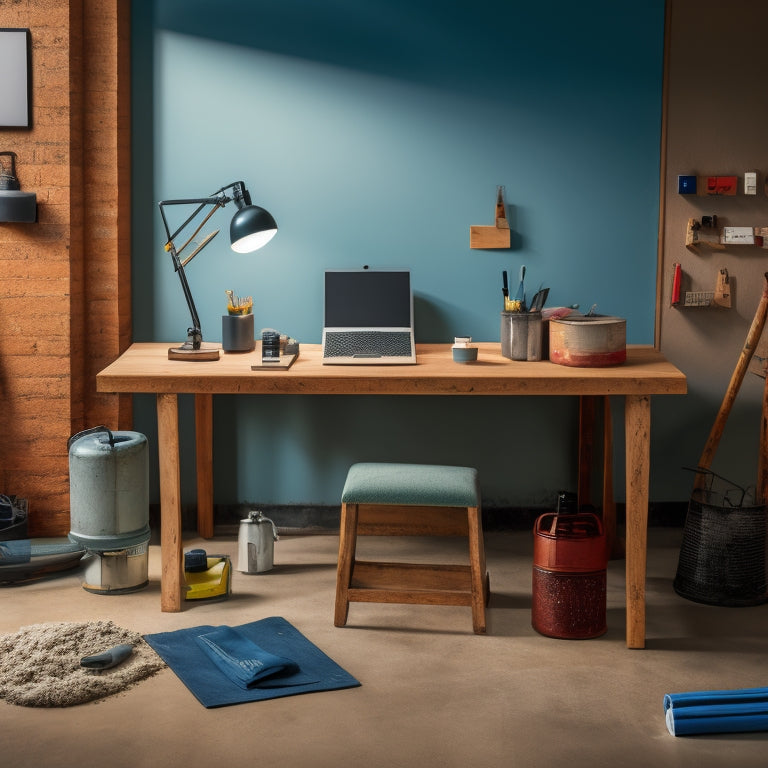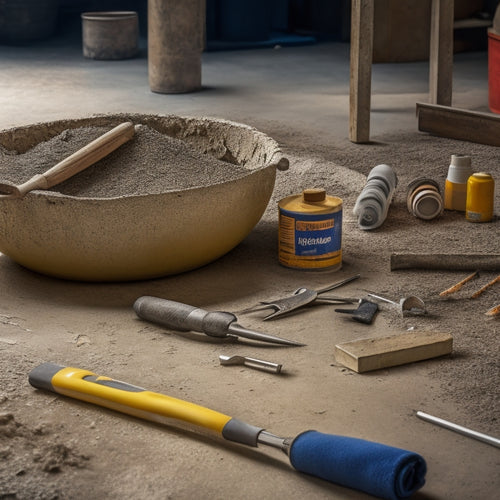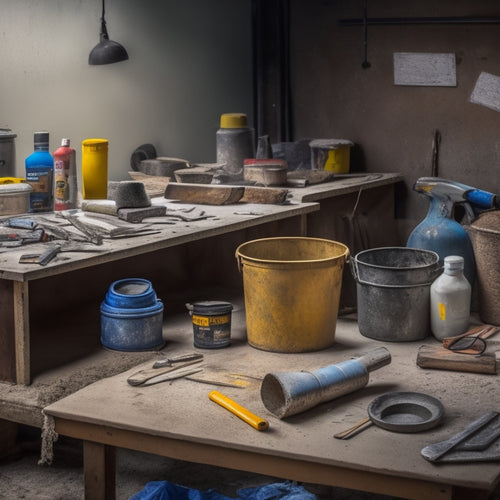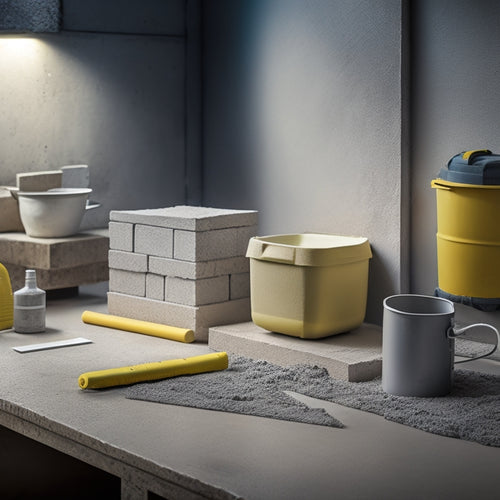
5 Best Tools for Concrete Stain Application Success
Share
When applying concrete stain, you'll need the right tools to achieve professional-looking results. Start with essential applicator brushes, choosing natural bristles for oil-based stains and synthetic for water-based. Select the right roller extension based on nap length, material, and pile density, and opt for high-quality sprayers that guarantee consistent color distribution. Don't forget vital cleaning tools like power washers and concrete cleaning solutions to prep the surface. Finally, measuring and mixing essentials like digital scales and mixing buckets will help you achieve the perfect blend. With these tools in hand, you're one step closer to revealing a stunning, long-lasting finish.
Key Takeaways
• Choose the right applicator brush, considering bristle material and stiffness, for smooth or textured finishes.
• Select a suitable roller extension based on nap length, material, and pile density for optimal coverage.
• Invest in high-quality sprayers, such as airless or handheld, for consistent color distribution and uniform finishes.
• Prepare surfaces with crucial cleaning tools like power washers, concrete cleaning solutions, and microfiber towels.
• Ensure accurate measurement and mixing of stain and solvent with digital scales, measuring cups, and mixing buckets.
Essential Applicator Brushes Needed
Select the right applicator brushes to guarantee a smooth, even concrete stain application, as they play a critical role in achieving the desired finish and color consistency.
You'll need to choose from various brush types, each suited for specific application techniques. Natural bristle brushes, for instance, are ideal for oil-based stains, while synthetic brushes work best with water-based stains.
When it comes to texture and pattern, you'll want to opt for a brush that complements your desired finish. For example, a brush with stiffer bristles will produce a more textured look, while a softer-bristled brush will yield a smoother finish.
When applying stain, use gentle, even strokes to maintain color consistency. Work in sections to prevent overlapping and unevenness.
Always follow the manufacturer's instructions for the recommended application technique, as different stains may require specific methods.
Choosing the Right Roller Extension
As you move on to applying concrete stain to larger areas, you'll need a roller extension that can efficiently cover more ground while maintaining the desired texture and pattern.
With various roller types available, it's vital to select the right one for your specific project. You'll want to take into account the nap length, material, and pile density to guarantee the best results. For instance, a microfiber roller is ideal for smooth, even finishes, while a wool roller is better suited for textured or rough surfaces.
When it comes to extension lengths, you'll need to factor in the reach and maneuverability required for your project. Extensions ranging from 2 to 4 feet are suitable for most applications, but longer or shorter lengths may be necessary depending on the area you're working with.
It's important to choose an extension that allows you to maintain control and stability while applying the stain, guaranteeing a safe and even application. By selecting the right roller extension, you'll be able to achieve professional-looking results while minimizing the risk of accidents and errors.
Best Sprayers for Even Coverage
You'll achieve even coverage and consistent color distribution by using a high-quality sprayer specifically designed for concrete stain application.
When selecting a sprayer, consider the type of stain you're using, the surface area, and the level of precision required. Airless sprayers are ideal for large surfaces, as they can cover a lot of ground quickly and efficiently. They're also great for achieving a uniform finish.
Handheld sprayers, on the other hand, are perfect for smaller areas, tight spaces, and detailed work. They offer greater precision and control, making them ideal for cutting in around edges, corners, and intricate designs.
When choosing between airless and handheld sprayers, consider the specific needs of your project. Both types of sprayers are designed for safety, with features like trigger locks and adjustable nozzles to prevent accidents and guarantee precise application.
Additionally, look for sprayers with durable construction, easy-to-clean designs, and comfortable grips to reduce fatigue and improve overall performance.
Crucial Cleaning Tools for Prep
Before applying concrete stain, thoroughly clean the surface to confirm a strong bond and ideal color retention. Use specialized cleaning tools to remove dirt, grime, and other substances that might compromise the stain's performance. You'll want to focus on surface preparation to achieve a successful stain application.
To confirm a clean and prepared surface, you'll need the following essential cleaning tools:
-
Power washer: A high-pressure power washer is vital for removing dirt, grime, and old sealers from the concrete surface.
-
Concrete cleaning solutions: Choose a cleaning solution specifically designed for concrete to effectively break down dirt and grime without damaging the surface.
-
Brooms and scrub brushes: Use sturdy brooms and scrub brushes to agitate the cleaning solution and remove stubborn dirt and grime.
-
Rinse water: Use clean water to thoroughly rinse the surface, removing any remaining dirt and cleaning solution.
-
Microfiber towels or squeegees: Use microfiber towels or squeegees to remove excess water and prevent water spots from forming.
Measuring and Mixing Essentials
Accurately measuring and mixing the concrete stain is essential to achieving the desired color and finish, so it is important to have the right tools for the job. You can't afford to compromise on the quality of your measurement tools, as this can lead to inaccurate ratios and a subpar finish.
To guarantee a successful stain application, you'll need the following essential tools:
| Tool | Purpose |
|---|---|
| Digital Scale | Precise measurement of stain and solvent |
| Measuring Cups | Accurate ratio mixing of stain and solvent |
| Mixing Bucket | Thorough blending of stain and solvent |
When it comes to mixing techniques, it's important to follow the manufacturer's instructions. Typically, you'll want to mix the stain and solvent in a well-ventilated area, using a low-speed drill or mixing stick to avoid creating air bubbles. Remember to mix in small batches to maintain consistency and avoid waste. By following these guidelines and using the right tools, you'll be well on your way to achieving a professional-looking finish.
Frequently Asked Questions
Can I Use a Regular Paintbrush for Applying Concrete Stain?
You're wondering if a regular paintbrush will do the trick for applying concrete stain. The short answer is, it's not the best choice.
You'll end up with uneven coverage and a high risk of brush strokes showing through. Instead, consider paintbrush alternatives like microfiber applicators or foam brushes, which provide a smooth, even finish.
Mastering application techniques like working in sections and using gentle, sweeping motions will also guarantee a professional-looking result.
How Long Does Concrete Stain Typically Take to Dry?
When you apply concrete stain, you'll want to know how long it takes to dry.
The drying time depends on drying conditions, such as temperature, humidity, and air circulation.
Typically, concrete stain takes anywhere from 15 minutes to an hour to dry to the touch, but it can take up to 24 hours to fully cure.
Keep in mind that stain absorption rates vary, so be patient and follow the manufacturer's instructions to guarantee a safe and successful application.
Is It Necessary to Seal the Concrete After Staining?
When you've achieved the perfect stain, you're probably wondering if sealing is necessary. The answer is yes.
Sealing your concrete after staining enhances stain longevity and protects it from fading, chalking, or becoming brittle. It also makes cleaning easier and more effective.
By sealing, you'll guarantee your beautifully stained concrete remains safe and durable, resisting damage from spills, UV rays, and heavy foot traffic.
Don't risk compromising your hard work – sealing is an essential step in maintaining your concrete's integrity.
Can I Stain Concrete That Has Been Previously Sealed?
When you're dealing with previously sealed concrete, you'll need to evaluate its condition before staining.
If the sealant is still intact, you'll have to remove it using stain removal techniques, such as chemical stripping or mechanical grinding.
Once the sealant is removed, you can proceed with staining.
However, if the sealant has broken down, you may be able to stain over it, but you'll need to contemplate new sealing options to guarantee a durable finish.
Always follow safety guidelines when working with chemicals and mechanical equipment.
Will Concrete Stain Work on Old or Damaged Concrete Surfaces?
When working with old or damaged concrete surfaces, you'll need to prioritize surface preparation to guarantee stain adhesion.
Start by cleaning the surface thoroughly to remove dirt, oil, and other substances that might interfere with the stain.
Next, repair any cracks or holes with a suitable patching compound, and allow it to fully cure.
Only then can you proceed with applying the concrete stain, following the manufacturer's instructions for ideal results.
Conclusion
You've made it to the final coat, and your concrete stain application is a work of art.
Like a master chef seasoning a dish, you've carefully selected and wielded the right tools to bring out the best flavors of your concrete.
With the right applicator brushes, roller extensions, sprayers, cleaning tools, and measuring essentials, you've guaranteed a harmonious blend of color and texture.
Now, step back and admire your masterpiece – a beautifully stained concrete surface that's sure to impress.
Related Posts
-

Top Tools for Repairing Cracked Concrete Surfaces
When tackling a cracked concrete surface repair, you'll need the right tools to guarantee a durable fix. Start with e...
-

3 Best Tools to Buy for Concrete Repair Online
When buying tools for concrete repair online, you'll want to research multiple retailer options to find the best prod...
-

What Tools Do I Need for Concrete Block Laying
You'll need a thorough set of tools to guarantee accurate, efficient, and professional concrete block laying. Essenti...


